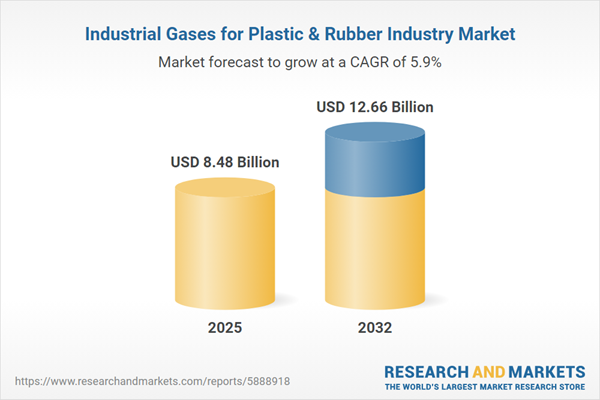Speak directly to the analyst to clarify any post sales queries you may have.
The industrial gases market is reshaping how the plastic and rubber sectors achieve production efficiency and regulatory compliance. Senior leaders today are seeking resilient solutions and advanced supply practices that safeguard operations and prepare their organizations for ongoing changes.
Market Snapshot: Industrial Gases in the Plastic & Rubber Industry
The global industrial gases market serving the plastic and rubber segments demonstrated robust growth in 2024, reaching USD 7.99 billion. Projections indicate continued expansion, with expectations to rise to USD 8.48 billion by 2025 and achieve USD 12.66 billion by 2032, marking a CAGR of 5.91%. This performance is underpinned by the widespread adoption of process automation, intensified emissions standards, and progressive advances in gas production technology. Digital transformation stands out as a key driver, allowing manufacturers to adapt with agility to regulatory changes, evolving customer preferences, and diverse supply scenarios, fostering increased operational resilience across the sector.
Scope & Segmentation of the Industrial Gases Market
- Gas Types: Argon, carbon dioxide, hydrogen, nitrogen, and oxygen each play a vital role in molding, extrusion, and surface processing. These gases are essential for chemical processes that underpin production quality and process consistency.
- Applications: Operations such as blow molding, film and pipe extrusion, calendering, and injection molding use industrial gases to produce components for critical industries including automotive, packaging, and electronics, where consistent quality and regulatory alignment are required.
- Supply Modes: Merchant supply, on-site generation, and custom delivery options enable manufacturers to better navigate variable operational cycles and mitigate supply chain challenges, ensuring dependable gas availability.
- Packaging Formats: Cylinders, liquid bulk containers, and on-site storage solutions support flexible, secure storage and delivery, catering to both high-volume production and specialized process needs.
- Purity Grades: Technical, ultra-high purity, and specialty gas grades allow manufacturers to meet stricter industry regulations and uphold product integrity, especially for sensitive and high-specification applications.
- Distribution Channels: Direct sales, strategic distribution alliances, and digital commerce open broader access to industrial gases globally, enhancing reliability and expanding reach for all supply participants.
- Regional Markets: Geographic diversity shapes supply approaches. North America, Europe, Asia-Pacific, the Middle East, and Africa each present unique technology adoption rates, regulatory frameworks, and logistical infrastructures, requiring nuanced strategies for engagement.
- Industry Leaders: Organizations such as Linde plc, Air Liquide S.A., Air Products and Chemicals, and Messer Group continue to set industry standards, advancing market development through targeted investments and a strong focus on technology platforms.
Key Takeaways: Strategic Trends for Decision-Makers
- Adoption of advanced analytics and sensor technologies gives managers real-time insights into supply chains, supporting proactive planning and improved sourcing predictability.
- Expanding green hydrogen and on-site oxygen capabilities elevates environmental performance and reduces reliance on traditional external sources.
- Closer collaboration between manufacturers and suppliers adds agility to supply networks, maintaining continuity during logistical or regulatory shifts.
- On-site generation minimizes risks of supply interruptions, strengthening production continuity and reinforcing disaster recovery strategies.
- Incorporation of high-purity gases enhances inerting, surface treatment, and process management, aligning outcomes with stringent application specifications within plastics and rubber manufacturing.
- Digital procurement and logistics optimization accelerate sourcing cycles, enabling manufacturers to better adapt within complex, distributed industrial environments.
Tariff Impact: Navigating Gas Cost Volatility
In North America, leading companies manage price volatility by broadening their supplier networks and investing in local gas generation solutions. These actions maintain stability and encourage advancements in recycling and gas purification, allowing businesses to remain responsive to regulatory developments and supply chain disruptions.
Methodology & Data Sources
This analysis draws on insights from industry experts, thorough literature review, corporate reporting, and patent records. Every research stage follows regulatory guidelines, ensuring findings are practical and applicable for specialty chemical and industrial gas professionals.
Why This Report Matters
- Equips senior leaders with actionable perspectives to refine sourcing, uphold compliance, and accelerate the adoption of emerging gas technologies.
- Enables organizations to strengthen risk management and maintain seamless operations, factoring in complex regional supply chain variables.
- Supports systematic selection and application of industrial gases to drive sustainability and maintain high productivity in core manufacturing environments.
Conclusion
Optimizing industrial gas management is essential for sustaining reliable, quality-focused plastic and rubber production. Strategic partnerships and digital solutions empower organizations to anticipate and address evolving industry needs confidently.
Additional Product Information:
- Purchase of this report includes 1 year online access with quarterly updates.
- This report can be updated on request. Please contact our Customer Experience team using the Ask a Question widget on our website.
Table of Contents
3. Executive Summary
4. Market Overview
7. Cumulative Impact of Artificial Intelligence 2025
Companies Mentioned
The companies profiled in this Industrial Gases for Plastic & Rubber Industry market report include:- Linde plc
- Air Liquide S.A.
- Air Products and Chemicals, Inc.
- Taiyo Nippon Sanso Corporation
- Messer Group GmbH
- Air Water Inc.
- Iwatani Corporation
- Gulf Cryo Holding Company
- SIAD S.p.A.
- Showa Denko K.K.
Table Information
| Report Attribute | Details |
|---|---|
| No. of Pages | 195 |
| Published | October 2025 |
| Forecast Period | 2025 - 2032 |
| Estimated Market Value ( USD | $ 8.48 Billion |
| Forecasted Market Value ( USD | $ 12.66 Billion |
| Compound Annual Growth Rate | 5.9% |
| Regions Covered | Global |
| No. of Companies Mentioned | 11 |









